Exploring Cameroon Pidgin English: A Linguistic Analysis Essay
VerifiedAdded on 2022/10/04
|5
|1121
|15
Essay
AI Summary
This essay provides a comprehensive analysis of Cameroon Pidgin English, a significant language in Cameroon. It begins by exploring the historical context of the language, tracing its origins to the interactions between European traders and the indigenous population in the 15th century and its subsequent development under British and German colonial rule. The essay then delves into the key linguistic features of Cameroon Pidgin, including its simplified grammar, reduced morphological complexity, semantic transparency, and reduced vocabulary. Finally, the essay considers the possible futures of Cameroon Pidgin, discussing its potential role in education, its close ties to local vernaculars, and its capacity to serve as a trans-border medium of communication. The analysis concludes that Cameroon Pidgin is likely to continue to grow in significance among Cameroonians.
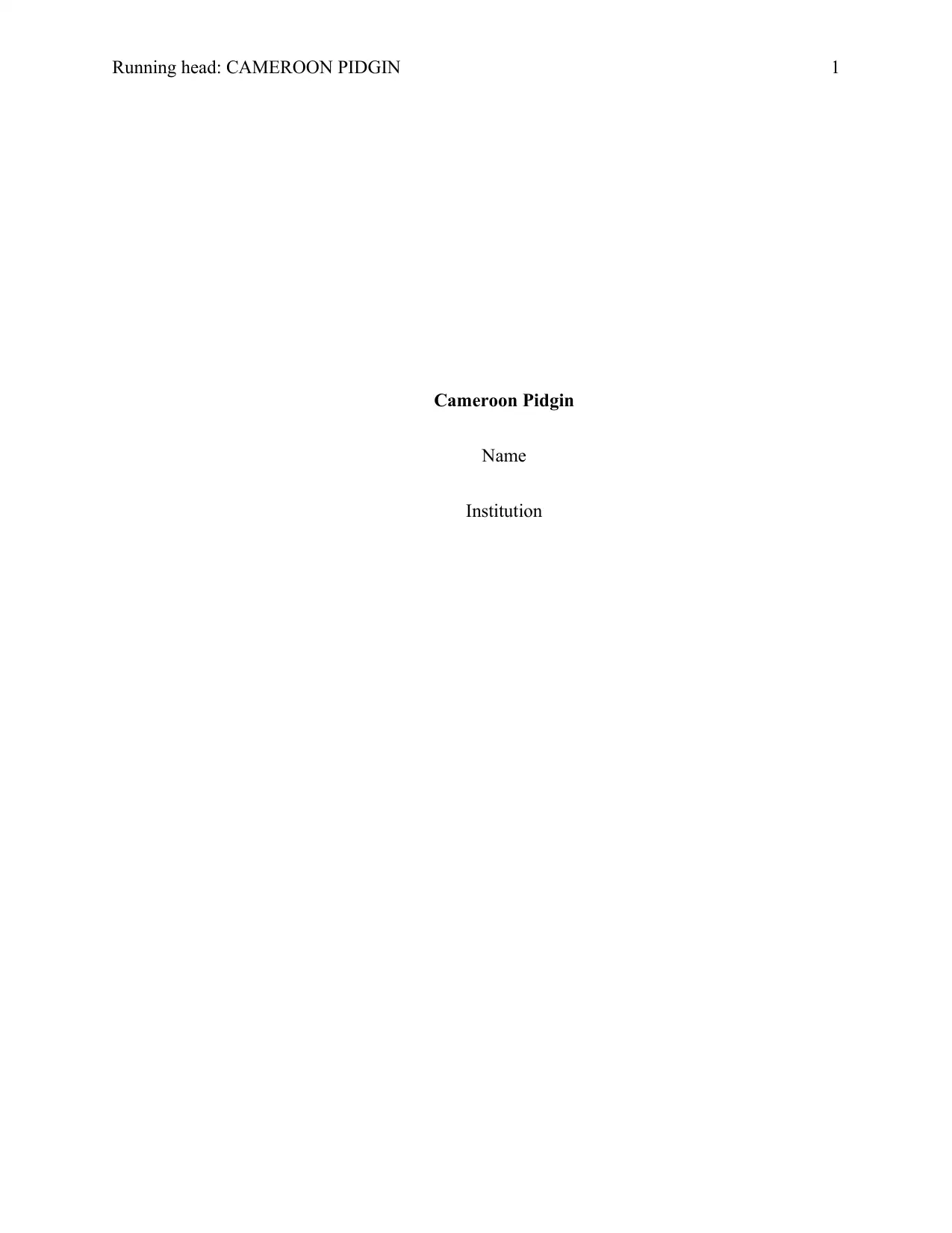
Running head: CAMEROON PIDGIN 1
Cameroon Pidgin
Name
Institution
Cameroon Pidgin
Name
Institution
Paraphrase This Document
Need a fresh take? Get an instant paraphrase of this document with our AI Paraphraser
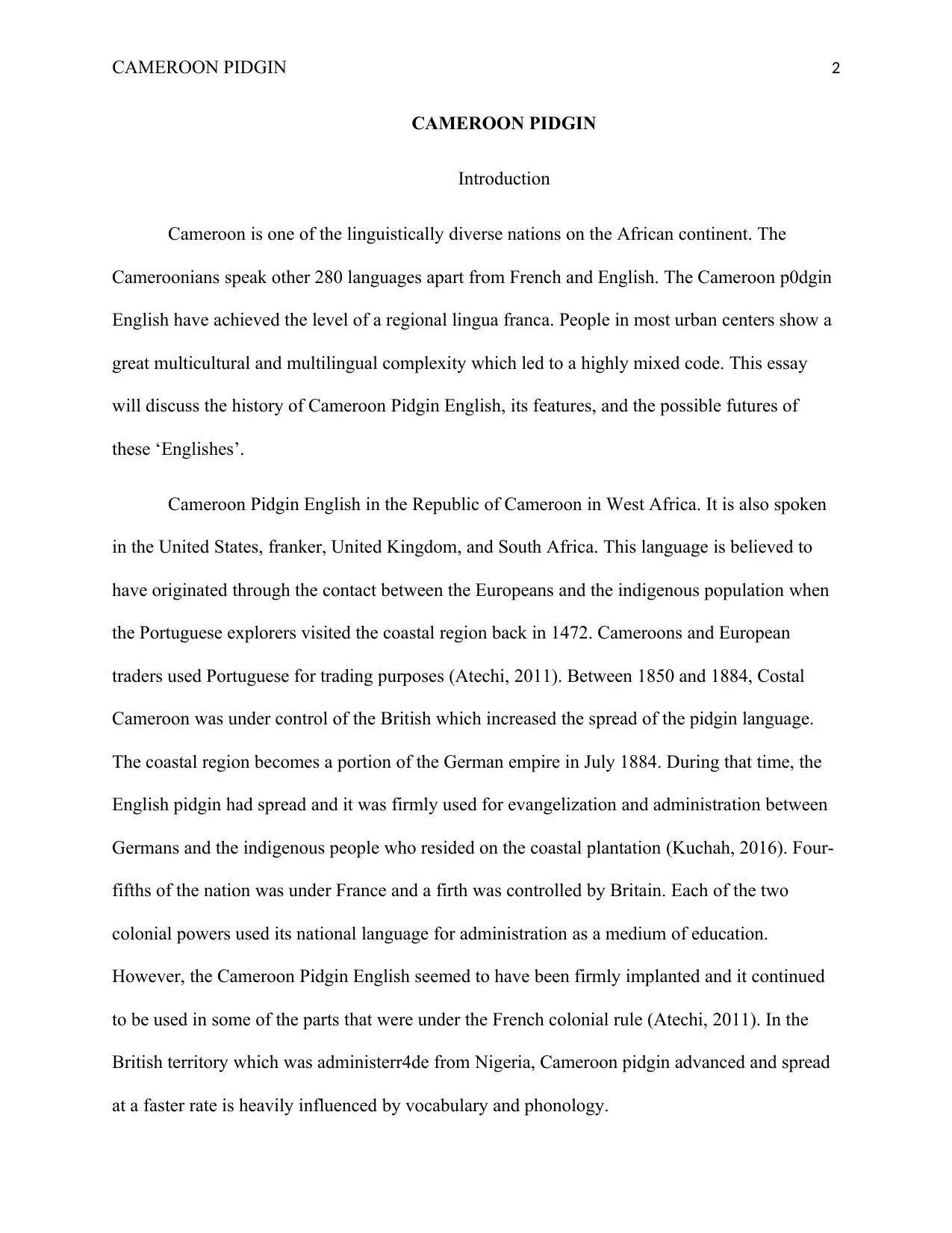
CAMEROON PIDGIN 2
CAMEROON PIDGIN
Introduction
Cameroon is one of the linguistically diverse nations on the African continent. The
Cameroonians speak other 280 languages apart from French and English. The Cameroon p0dgin
English have achieved the level of a regional lingua franca. People in most urban centers show a
great multicultural and multilingual complexity which led to a highly mixed code. This essay
will discuss the history of Cameroon Pidgin English, its features, and the possible futures of
these ‘Englishes’.
Cameroon Pidgin English in the Republic of Cameroon in West Africa. It is also spoken
in the United States, franker, United Kingdom, and South Africa. This language is believed to
have originated through the contact between the Europeans and the indigenous population when
the Portuguese explorers visited the coastal region back in 1472. Cameroons and European
traders used Portuguese for trading purposes (Atechi, 2011). Between 1850 and 1884, Costal
Cameroon was under control of the British which increased the spread of the pidgin language.
The coastal region becomes a portion of the German empire in July 1884. During that time, the
English pidgin had spread and it was firmly used for evangelization and administration between
Germans and the indigenous people who resided on the coastal plantation (Kuchah, 2016). Four-
fifths of the nation was under France and a firth was controlled by Britain. Each of the two
colonial powers used its national language for administration as a medium of education.
However, the Cameroon Pidgin English seemed to have been firmly implanted and it continued
to be used in some of the parts that were under the French colonial rule (Atechi, 2011). In the
British territory which was administerr4de from Nigeria, Cameroon pidgin advanced and spread
at a faster rate is heavily influenced by vocabulary and phonology.
CAMEROON PIDGIN
Introduction
Cameroon is one of the linguistically diverse nations on the African continent. The
Cameroonians speak other 280 languages apart from French and English. The Cameroon p0dgin
English have achieved the level of a regional lingua franca. People in most urban centers show a
great multicultural and multilingual complexity which led to a highly mixed code. This essay
will discuss the history of Cameroon Pidgin English, its features, and the possible futures of
these ‘Englishes’.
Cameroon Pidgin English in the Republic of Cameroon in West Africa. It is also spoken
in the United States, franker, United Kingdom, and South Africa. This language is believed to
have originated through the contact between the Europeans and the indigenous population when
the Portuguese explorers visited the coastal region back in 1472. Cameroons and European
traders used Portuguese for trading purposes (Atechi, 2011). Between 1850 and 1884, Costal
Cameroon was under control of the British which increased the spread of the pidgin language.
The coastal region becomes a portion of the German empire in July 1884. During that time, the
English pidgin had spread and it was firmly used for evangelization and administration between
Germans and the indigenous people who resided on the coastal plantation (Kuchah, 2016). Four-
fifths of the nation was under France and a firth was controlled by Britain. Each of the two
colonial powers used its national language for administration as a medium of education.
However, the Cameroon Pidgin English seemed to have been firmly implanted and it continued
to be used in some of the parts that were under the French colonial rule (Atechi, 2011). In the
British territory which was administerr4de from Nigeria, Cameroon pidgin advanced and spread
at a faster rate is heavily influenced by vocabulary and phonology.
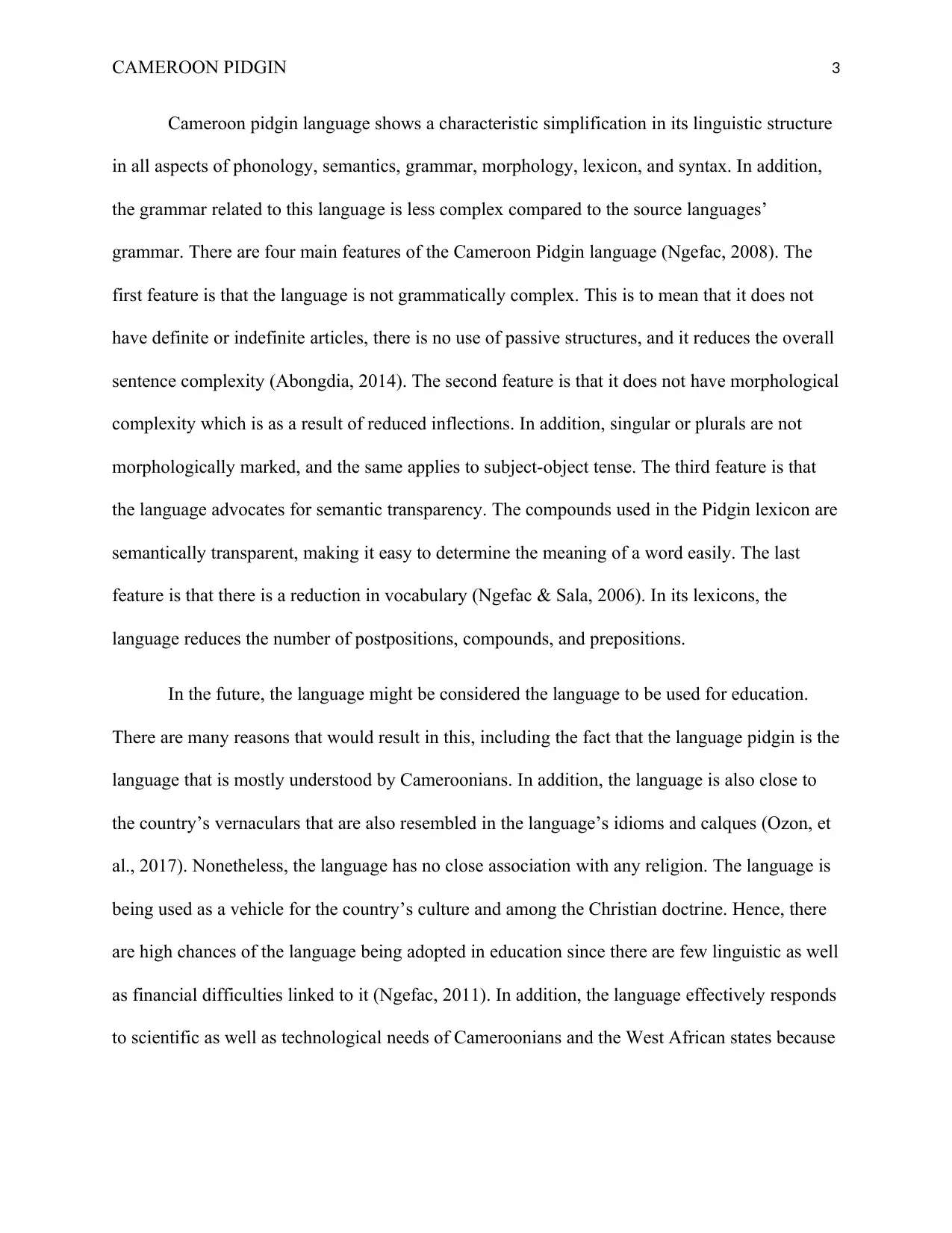
CAMEROON PIDGIN 3
Cameroon pidgin language shows a characteristic simplification in its linguistic structure
in all aspects of phonology, semantics, grammar, morphology, lexicon, and syntax. In addition,
the grammar related to this language is less complex compared to the source languages’
grammar. There are four main features of the Cameroon Pidgin language (Ngefac, 2008). The
first feature is that the language is not grammatically complex. This is to mean that it does not
have definite or indefinite articles, there is no use of passive structures, and it reduces the overall
sentence complexity (Abongdia, 2014). The second feature is that it does not have morphological
complexity which is as a result of reduced inflections. In addition, singular or plurals are not
morphologically marked, and the same applies to subject-object tense. The third feature is that
the language advocates for semantic transparency. The compounds used in the Pidgin lexicon are
semantically transparent, making it easy to determine the meaning of a word easily. The last
feature is that there is a reduction in vocabulary (Ngefac & Sala, 2006). In its lexicons, the
language reduces the number of postpositions, compounds, and prepositions.
In the future, the language might be considered the language to be used for education.
There are many reasons that would result in this, including the fact that the language pidgin is the
language that is mostly understood by Cameroonians. In addition, the language is also close to
the country’s vernaculars that are also resembled in the language’s idioms and calques (Ozon, et
al., 2017). Nonetheless, the language has no close association with any religion. The language is
being used as a vehicle for the country’s culture and among the Christian doctrine. Hence, there
are high chances of the language being adopted in education since there are few linguistic as well
as financial difficulties linked to it (Ngefac, 2011). In addition, the language effectively responds
to scientific as well as technological needs of Cameroonians and the West African states because
Cameroon pidgin language shows a characteristic simplification in its linguistic structure
in all aspects of phonology, semantics, grammar, morphology, lexicon, and syntax. In addition,
the grammar related to this language is less complex compared to the source languages’
grammar. There are four main features of the Cameroon Pidgin language (Ngefac, 2008). The
first feature is that the language is not grammatically complex. This is to mean that it does not
have definite or indefinite articles, there is no use of passive structures, and it reduces the overall
sentence complexity (Abongdia, 2014). The second feature is that it does not have morphological
complexity which is as a result of reduced inflections. In addition, singular or plurals are not
morphologically marked, and the same applies to subject-object tense. The third feature is that
the language advocates for semantic transparency. The compounds used in the Pidgin lexicon are
semantically transparent, making it easy to determine the meaning of a word easily. The last
feature is that there is a reduction in vocabulary (Ngefac & Sala, 2006). In its lexicons, the
language reduces the number of postpositions, compounds, and prepositions.
In the future, the language might be considered the language to be used for education.
There are many reasons that would result in this, including the fact that the language pidgin is the
language that is mostly understood by Cameroonians. In addition, the language is also close to
the country’s vernaculars that are also resembled in the language’s idioms and calques (Ozon, et
al., 2017). Nonetheless, the language has no close association with any religion. The language is
being used as a vehicle for the country’s culture and among the Christian doctrine. Hence, there
are high chances of the language being adopted in education since there are few linguistic as well
as financial difficulties linked to it (Ngefac, 2011). In addition, the language effectively responds
to scientific as well as technological needs of Cameroonians and the West African states because
⊘ This is a preview!⊘
Do you want full access?
Subscribe today to unlock all pages.

Trusted by 1+ million students worldwide
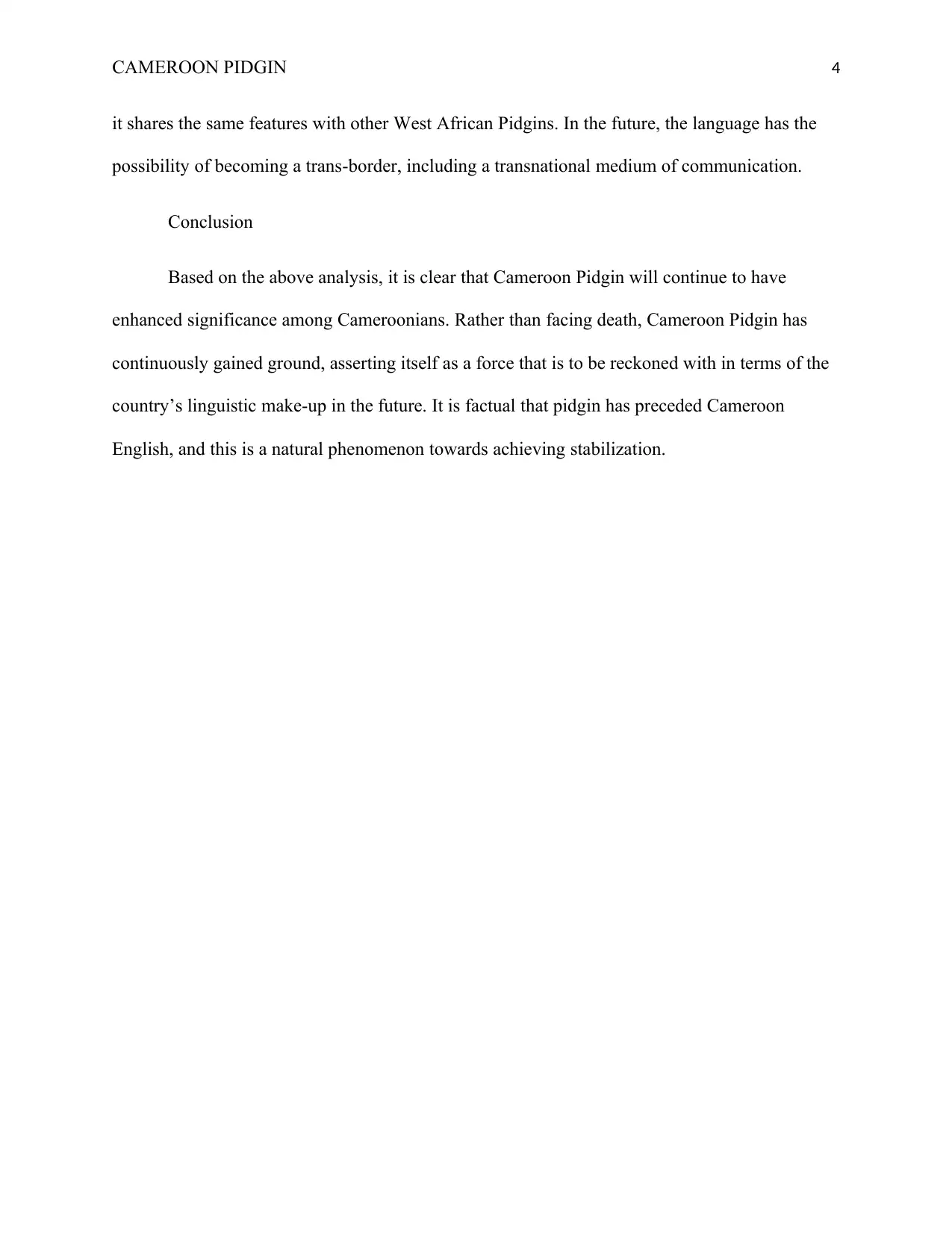
CAMEROON PIDGIN 4
it shares the same features with other West African Pidgins. In the future, the language has the
possibility of becoming a trans-border, including a transnational medium of communication.
Conclusion
Based on the above analysis, it is clear that Cameroon Pidgin will continue to have
enhanced significance among Cameroonians. Rather than facing death, Cameroon Pidgin has
continuously gained ground, asserting itself as a force that is to be reckoned with in terms of the
country’s linguistic make-up in the future. It is factual that pidgin has preceded Cameroon
English, and this is a natural phenomenon towards achieving stabilization.
it shares the same features with other West African Pidgins. In the future, the language has the
possibility of becoming a trans-border, including a transnational medium of communication.
Conclusion
Based on the above analysis, it is clear that Cameroon Pidgin will continue to have
enhanced significance among Cameroonians. Rather than facing death, Cameroon Pidgin has
continuously gained ground, asserting itself as a force that is to be reckoned with in terms of the
country’s linguistic make-up in the future. It is factual that pidgin has preceded Cameroon
English, and this is a natural phenomenon towards achieving stabilization.
Paraphrase This Document
Need a fresh take? Get an instant paraphrase of this document with our AI Paraphraser
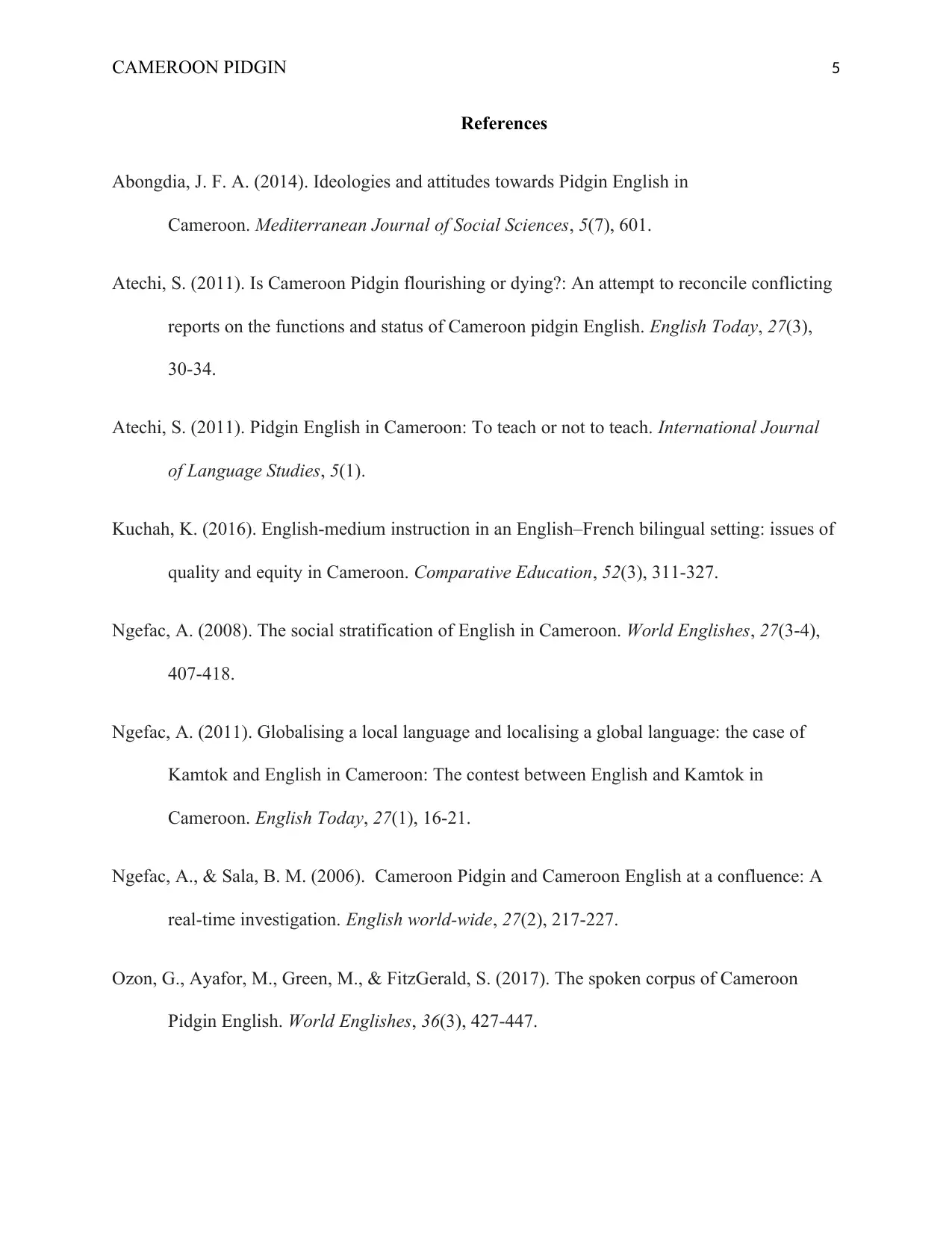
CAMEROON PIDGIN 5
References
Abongdia, J. F. A. (2014). Ideologies and attitudes towards Pidgin English in
Cameroon. Mediterranean Journal of Social Sciences, 5(7), 601.
Atechi, S. (2011). Is Cameroon Pidgin flourishing or dying?: An attempt to reconcile conflicting
reports on the functions and status of Cameroon pidgin English. English Today, 27(3),
30-34.
Atechi, S. (2011). Pidgin English in Cameroon: To teach or not to teach. International Journal
of Language Studies, 5(1).
Kuchah, K. (2016). English-medium instruction in an English–French bilingual setting: issues of
quality and equity in Cameroon. Comparative Education, 52(3), 311-327.
Ngefac, A. (2008). The social stratification of English in Cameroon. World Englishes, 27(3 4),‐
407-418.
Ngefac, A. (2011). Globalising a local language and localising a global language: the case of
Kamtok and English in Cameroon: The contest between English and Kamtok in
Cameroon. English Today, 27(1), 16-21.
Ngefac, A., & Sala, B. M. (2006). Cameroon Pidgin and Cameroon English at a confluence: A
real-time investigation. English world-wide, 27(2), 217-227.
Ozon, G., Ayafor, M., Green, M., & FitzGerald, S. (2017). The spoken corpus of Cameroon
Pidgin English. World Englishes, 36(3), 427-447.
References
Abongdia, J. F. A. (2014). Ideologies and attitudes towards Pidgin English in
Cameroon. Mediterranean Journal of Social Sciences, 5(7), 601.
Atechi, S. (2011). Is Cameroon Pidgin flourishing or dying?: An attempt to reconcile conflicting
reports on the functions and status of Cameroon pidgin English. English Today, 27(3),
30-34.
Atechi, S. (2011). Pidgin English in Cameroon: To teach or not to teach. International Journal
of Language Studies, 5(1).
Kuchah, K. (2016). English-medium instruction in an English–French bilingual setting: issues of
quality and equity in Cameroon. Comparative Education, 52(3), 311-327.
Ngefac, A. (2008). The social stratification of English in Cameroon. World Englishes, 27(3 4),‐
407-418.
Ngefac, A. (2011). Globalising a local language and localising a global language: the case of
Kamtok and English in Cameroon: The contest between English and Kamtok in
Cameroon. English Today, 27(1), 16-21.
Ngefac, A., & Sala, B. M. (2006). Cameroon Pidgin and Cameroon English at a confluence: A
real-time investigation. English world-wide, 27(2), 217-227.
Ozon, G., Ayafor, M., Green, M., & FitzGerald, S. (2017). The spoken corpus of Cameroon
Pidgin English. World Englishes, 36(3), 427-447.
1 out of 5
Your All-in-One AI-Powered Toolkit for Academic Success.
+13062052269
info@desklib.com
Available 24*7 on WhatsApp / Email
![[object Object]](/_next/static/media/star-bottom.7253800d.svg)
Unlock your academic potential
Copyright © 2020–2025 A2Z Services. All Rights Reserved. Developed and managed by ZUCOL.